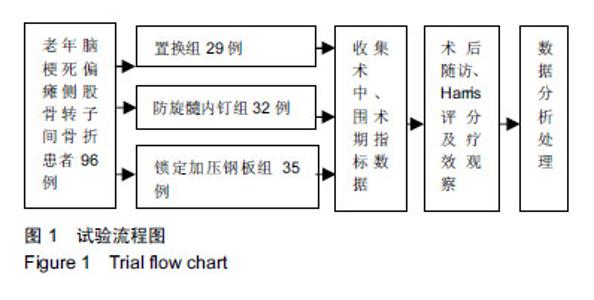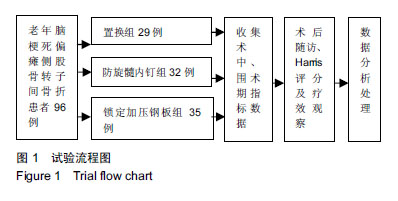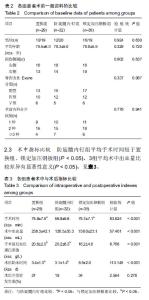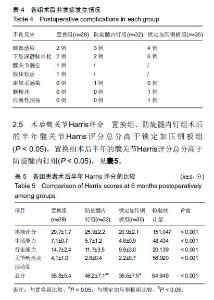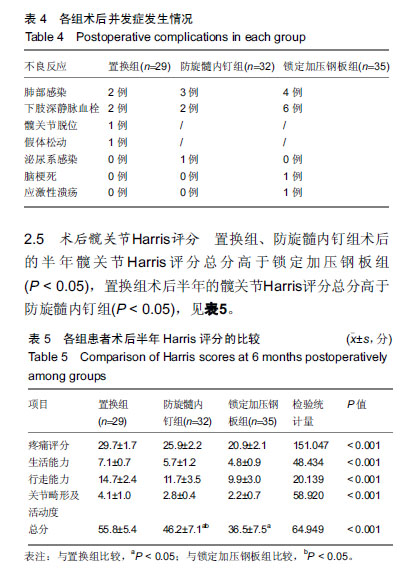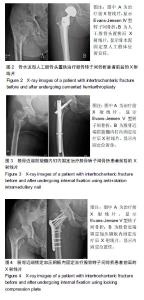| [1]Tucker A,Donnelly KJ,Rowan C,et al.Is the best plate a nail? A review of 3230 unstable intertrochanteric fractures of the proximal femur.J Orthop Trauma.2018|32(2):53-60.[2]Hiragami K,Ishii J.Embedding the lateral end of the lag screw within the lateral wall in the repair of reverse obliquity intertrochanteric femur fracture.J Int Med Res. 2018;46(3):1103-1108.[3]Yoo JI,Ha YC,Lim JY,et al.Early Rehabilitation in Elderly after Arthroplasty versus Internal Fixation for Unstable Intertrochanteric Fractures of Femur: Systematic Review and Meta-Analysis.J Korean Med Sci.2017;32(5):858-867.[4]王凌斌,朴民声,陆龙卫,等.手术时机对70岁以上股骨转子间骨折预后的影响[J].中国矫形外科杂志, 2018,26(8):712-715. [5]Parker MJ,Cawley S.Sliding hip screw versus the Targon PFT nail for trochanteric hip fractures: a randomised trial of 400 patients.Bone Joint J.2017;99-B(9):1210-1215.[6]Zhang H,Zeng X,Zhang N,et al.INTERTAN nail versus proximal femoral nail antirotation-Asia for intertrochanteric femur fractures in elderly patients with primary osteoporosis.J Int Med Res.2017;45(4):1297-1309.[7]Shah MD,Kapoor CS,Soni RJ,et al.Evaluation of outcome of proximal femur locking compression plate (PFLCP) in unstable proximal femur fractures.J Clin Orthop Trauma.2017;8(4):308-312. [8]唐佩福.股骨转子间骨折的治疗进展与策略[J].中华创伤骨科杂志,2017, 19(2):93-94. [9]Karapinar L,Kumbaraci M,Kaya A,et al.Proximal femoral nail anti-rotation (PFNA) to treat peritrochanteric fractures in elderly patients.Eur J Orthop Surg Traumatol. 2012;22(3):237-243. [10]Viste A,Perry KI,Taunton MJ,et al.Proximal femoral replacement in contemporary revision total hip arthroplasty for severe femoral bone loss: a review of outcomes.Bone Joint J. 2017;99-B(3):325-329. [11]Kovalak E,Ermutlu C,Atay T,et al. Management of unstable pertrochanteric fractures with proximal femoral locking compression plates and affect of neck-shaft angle on functional outcomes.J Clin Orthop Trauma. 2017;8(3):209-214. [12]胡文雄,蒋家正,韩宏德,等.股骨近端防旋髓内钉和解剖型锁定钢板治疗不稳定型股骨粗隆间骨折的临床疗效比较[J].中国老年学杂志, 2016,36(4): 903-904. [13]Wong JS,Brooks D,Inness EL,et al.The Impact of Falls on Motor and Cognitive Recovery after Discharge from In-Patient Stroke Rehabilitation.J Stroke Cerebrovasc Dis.2016;25(7):1613-1621. [14]Haddaway MJ,Bainbridge NJ,Powell DE,et al.Bone Resorption in Stroke and Institutionalized Subjects.Calcif Tissue Int. 2009;84(2):118-125. [15]江海良,郭开今,王翔,等.生物型与骨水泥型假体半髋置换治疗老年不稳定性股骨转子间骨折的比较[J]. 中国组织工程研究, 2017,21(23):3622-3627. [16]吴强,王欣,杨旭,等.股骨转子间骨折围手术期隐性失血的性别差异研究[J].中华骨科杂志,2017, 37(1):31-35.[17]危杰,王军,高明,等.老年髋部骨折围手术期失血量的分析[J].中华创伤骨科杂志,2015,17(2):104-107. [18]Lorich DG,Geller DS,Nielson JH.Osteoporotic pertrochanteric hip fractures: management and current controversies.Instr Course Lect. 2004;53(2):441-454. [19]Esen E,Dur H,Atao?lu MB,et al.Evaluation of proximal femoral nail-antirotation and cemented, bipolar hemiarthroplasty with calcar replacement in treatment of intertrochanteric femoral fractures in terms of mortality and morbidity ratios.Eklem Hastalik Cerrahisi.2017;28(1):35-40.[20]Reindl R,Harvey EJ,Berry GK,et al.Intramedullary Versus Extramedullary Fixation for Unstable Intertrochanteric Fractures: A Prospective Randomized Controlled Trial.J Bone Joint Surg Am.2015; 97(23):1905-1912. [21]Kleweno C,Morgan J,Redshaw J,et al.Short versus long cephalomedullary nails for the treatment of intertrochanteric hip fractures in patients older than 65 years.J Orthop Trauma. 2014;28(7):391-397. [22]杨力,孙奇,易立明,等.人工股骨头置换与髓内固定治疗脑卒中后老年股骨转子间骨折的疗效比较[J].中华创伤骨科杂志, 2013,15(5):397-401. |
